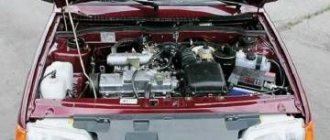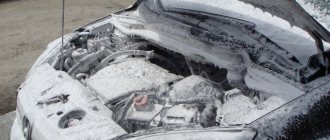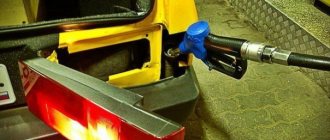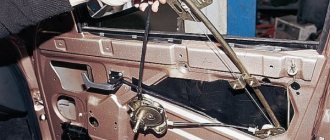The good performance of the VAZ 2114 engine is largely due to the good formation of the spark and fuel mixture. If one of these parameters is violated in a car, the engine may behave unpredictably.
Quite often, Samara 2 owners are faced with the problem of a stalling engine, and it occurs for many different reasons. This problem can really fray the nerves of those who are trying to solve this problem on their own.
In this article we will describe in detail how to independently diagnose the cause of engine tripping and failure of one or even two cylinders on a VAZ 2114.
Troit or not
How to understand that the engine in a VAZ 2114 is malfunctioning is quite simple, you just need to carefully listen to the operation of the internal combustion engine, and when driving, it is quite difficult not to notice that one of the cylinders is not working in the car.
Signs of a stalling engine:
- Loss of power;
- Vibrations;
- The engine shakes;
- Pops from the exhaust pipe;
If your car shows such signs of malfunction, most likely one or even two cylinders are not working.
Power system diagnostics
The engine is running hot, the reason is that only one spark plug is “wet”, and the rest are “dry”.
- If the tripping continues, swap the “dry” and “wet” spark plugs. Check, unscrew the spark plugs. If a dry spark plug remains dry and a wet spark plug stays wet, the cause is the spark plug. Replace the faulty (“wet”) one with a serviceable one. If the “dry” has become “wet”, and the “wet” has become “dry”, we return to the high-voltage wire. We replace it with a good one and check it. Important: specifically for a tested and working one, and not for a new one. No one has yet canceled a factory defect. If this does not help, we move on to the ignition system. In older engine models, high-voltage wires were connected to the ignition distributor (distributor); in new ones, each cylinder (or pair) is equipped with an individual ignition coil. Dry the distributor cover, clean and adjust the contacts, or replace it entirely. Well, a spare distributor cap in an old car should be a must, like a first aid kit with a fire extinguisher. In new engines, swap the ignition coils from adjacent cylinders. Naturally, wires too. Check it out. If necessary, replace the faulty coil.
It should be noted that checking for a spark with a spark plug removed from the engine does not help much. Such a common reason as the failure of an individual ignition coil of a modern engine may lie not only in the absence of a spark, but also in its weak strength. Or in general - the power of the spark is excellent, but... when the coil heats up, either the power of the spark drops, or its combustion phase “floats” and it does not ignite the fuel mixture. Why should the performance of an individual ignition coil be checked experimentally, and not according to self-diagnosis and engine tests: diagnostics and self-diagnosis will not show malfunctions of a “dying” coil, that is, a coil that periodically operates in abnormal mode. It can “die” for a year, and self-diagnosis will consider it normal all this time - after all, during the test it shows the norm... As practice shows, it is the abnormal operation of the individual ignition coil that most often leads to “hot” engine tripping.
The operation of the motor can be accompanied by various problems. All of them must be immediately eliminated. For example, a VAZ 2110 engine with an 8-valve injector shakes at idle, but after the car warms up enough, everything comes back to order. Many car owners try not to focus on this and continue to operate the car. Meanwhile, they do this in vain, since the existing problem requires a solution.
How to find out which cylinder is not working
In order to find out exactly which of several cylinders is not working, you can use two methods: checking through an OBD scanner and the good old test by elimination. Let's consider both options in more detail.
Scanner check
You need to purchase a special scanner ELM327, which connects to the OBD2 connector. Then the car diagnostic application is downloaded on the phone and paired with the scanner via Bluetooth.
The scanner reads errors from the electronic control unit through a connector and indicates a malfunction. Thus, it is possible to determine which cylinder has failed.
Checking by elimination
This check involves listening to the sound of the engine. If the car is shaking, then you need to open the hood, remember the sound of the internal combustion engine and, one by one, using pliers with insulated handles, remove the caps of the high-voltage wires from the spark plugs.
When the cap is removed from the working cylinder, the sound of the internal combustion engine will change and the engine speed will drop. This is a sign of normal operation of the cylinder, but if the sound of the engine does not change when the cap is removed, this means that this particular cylinder is not working.
High voltage wires
Checking high-voltage wires is mandatory when diagnosing an engine when it is tripping. There should be no traces of breakdown on them. Spark plug tips must be clean and free of carbon deposits.
After visually inspecting the spark plugs, check the high-voltage wires. There should be no traces of breakdown: black dots or stripes. Due to the breakdown, the current does not reach the spark plugs. This defect is the next reason for the tripping of an internal combustion engine.
Checking the wires yourself will not cause difficulties. They are tested with a conventional multimeter. It is necessary to measure the resistance of each wire.
Video of checking BB wires
Check the wires with a multimeter. Measure the resistance of each wire. It differs for different car brands, but does not exceed 20 kOhm. Good wires have the same resistance. If one of them shows much less or more, then it is faulty and because of it the power unit is tripping.
Reasons why the engine starts to stall
Engine trouble occurs for several reasons. When a cylinder fails in an internal combustion engine, it greatly affects its operation and it is simply impossible not to notice this.
List of reasons why the internal combustion engine fails:
- Wear of high-voltage wires;
- Failure of spark plugs;
- The ignition module is faulty;
- Clogged fuel injectors;
- Valve burnout;
- CPG wear;
- Failure or incorrect operation of the DPKV;
- ECU failure;
As you can see, there are quite a few reasons for the appearance of this malfunction on the VAZ 2114, and in order to understand which of them is the source of the breakdown on your car, you need to check all points and exclude some points in order to come to one conclusion.
Where did this name for the breakdown come from?
Why do engines with such a malfunction always “triple” and not “double” or “quadruple”? The fact is that most engines of previous generations had 4 cylinders. Accordingly, when one stopped working, only 3 of them moved in the motor. At the same time, the sound of the engine changed significantly. Subsequently, such a characteristic name for the breakdown as “triple” appeared. That is, only 3 cylinders work.
However, nowadays a 6- or even an 8-cylinder car engine can triple. Yes, from a scientific point of view, it is not entirely correct to use this term, but most of our auto mechanics characterize this breakdown in exactly this way. And it doesn’t matter how many cylinders the engine has - four, eight or twelve.
Why does the VAZ 2114 cylinder not work?
In order to make sure exactly why the cylinder failed, it is necessary to check all the elements that could cause the cylinder to fail.
Always start with the spark plugs
Checking the spark plugs
Checking the performance of the spark plug must be done on a special stand or by unscrewing the spark plug and putting it on its cap and placing it on the valve cover. Then ask someone you know or passerby to turn the starter. A spark should appear on the spark plug periodically. If it is missing, then the reason is in the candle.
It is better to check the spark plug on a cylinder that was initially in working condition.
Checking wires
High-voltage wires are made of special material with high insulation resistance to ensure reliable transmission of high voltage to the spark plug.
It is necessary to inspect the wires for breaks or damage to the insulation. The wire cap must be securely fixed to the spark plug and press the contact tightly against it.
If the wires have a characteristic worn appearance, they must be replaced.
Ignition module
The ignition module on the VAZ 2114 has two coils inside, each of which regulates the voltage supply to two cylinders. For example, the first coil is responsible for the operation of 1-4 cylinders, and the second is responsible for the operation of 2-3 cylinders.
From this we can conclude that if two cylinders, namely 1-4 or 2-3, do not work at once, then most likely there is a breakdown in the ignition module.
You can accurately verify this by removing this part from another car and installing it on a faulty car for testing.
Clogged fuel injectors
The injectors spray fuel into the combustion chamber. The VAZ 2114 has one injector for each cylinder. If one of the injectors becomes clogged, then the operation of this cylinder becomes impossible due to the lack of fuel mixture in it.
Checking the injectors can be done by measuring the fuel pressure and opening one of the injectors. The best way is to remove the fuel rail and wash the injectors.
Valves problem
Burnout of valves significantly affects the operation of the entire internal combustion engine. It occurs due to incorrect valve adjustment, namely when the valve is pressed and constantly open.
Also, if the valves are not adjusted correctly, engine tripping may occur.
You can check this by measuring the compression. To do this, instead of a spark plug, we screw in a compression gauge (a device for measuring compression in the engine) and the starter turns several revolutions. If there is no compression or it is much lower, then most likely the valve in the internal combustion engine is burnt out or incorrectly adjusted, or the CPG is worn out. To prevent wear on the CPG, it is necessary to drop some engine oil into the engine and measure again. Engine oil helps increase compression when the piston and rings wear. If there is no compression upon repeated measurement, then there is a problem with the valve.
DPKV failure
The sensor that takes readings from the rotation of the crankshaft is called DPKV. It determines the position of the piston in the engine and sends signals to the ECU. The sensor is directly involved in spark formation. If it fails, there will be no spark on all four cylinders and the engine will not be able to start.
Breakdown in the ECU
The control unit contains an electrical board with a large number of radio elements. Each element is responsible for a specific sensor. Special keys are responsible for the operation of the ignition module, which quite often fail, which makes it impossible to supply a spark to a certain cylinder.
If the engine in your car is not working, and you have tried all the methods, then it is best to contact an experienced electrician who can diagnose a breakdown in the engine control unit.
Minus one: easy ways to find the cause of the motor tripping
This is “boo-boo-boo” for a reason!
There will be very little theory today.
Engine trouble is when, for some reason, on a four-cylinder engine, one of the cylinders begins to misfire. Although once on the Internet I came across a funny theory that tripling is when one of the strokes is missing in a four-stroke engine. Well, it happens. I will not comment on this scientific discovery. Anyone who started their journey as a motorist with a “nine” or something similar spiritual and strong will immediately roll up their sleeves and in most cases find the cause of the malfunction. Those who have recently driven a fuel-injected car and confuse the DPKV (which we wrote about not long ago) and the oxygen sensor have a more difficult time. It seems that there are too many smart things, blocks, sensors and other “computers”, and it’s difficult to understand such a motor. There is some truth in this. The death of the same DPKV can lead to an uncertain start of the engine and to its tripping. But let's face it: it's not very often that these sensors die on their own, and the reason for the tripping is much more often much simpler. And finding it on your own is not only easy, but also pleasant.
The tripling itself is impossible not to notice. The engine runs unevenly, instead of a uniform “trrrrr”, some kind of uneven “trrr-bu-trrr-boo” is heard from the exhaust pipe, and sometimes it can make a rather loud bang (if gasoline accumulates in the exhaust, evaporates and escapes from the heating iron). Sometimes (but not always) the Check Engine light will flash or stay on. And this is already a good reason to do diagnostics.
I want to warn you right away: computer diagnostics in themselves are a necessary and good thing, but you shouldn’t hope that someone will connect their Chinese ELM 327 scanner to your car for 500 rubles and immediately make a diagnosis. Most likely, the result of such a diagnosis will be the phrase “misfire in such and such a cylinder,” and that’s all. Why the pass, where does the pass come from, what to do with it - all this confuses such a would-be diagnostician. In response, you will see his look, the way a reclusive pensioner looks at Eldzhey, and you will hear an indistinct bleat. So if you don’t have the money or the desire to go straight to a good but expensive diagnostician, it makes sense to deal with the engine yourself. For example, I will disassemble the simplest naturally aspirated four-cylinder gasoline engine, of which the majority are found in modern budget cars.
I propose a non-standard approach to solving the problem. We will not go from causes to consequences, but vice versa - the way we encounter it in life. That is, we will first carefully examine under what conditions tripling occurs, and based on this information, we will think about why it might appear. Let's start with the simplest case - tripping after a morning start in wet weather.
Morning, rain, no spark
Situation: in warm and dry or fairly frosty weather, the engine starts easily in the morning, but in wet or rainy weather it is difficult. After starting, the engine starts to run smoothly as it warms up. This is the simplest and most classic case, which is quite easy to overcome.
Almost always in this case the ignition system is to blame - high-voltage wires or the ignition coil. During the night they can become damp, and the spark that escaped through the breakdown begins to walk along their damp surface. As it warms up and dries, the problem disappears on its own, and appears again in the morning. In dry weather, of course, much less often.
Of course, it would be best to have a scanner for this case: it would make it possible to determine exactly in which cylinder the misfires began. Then it would be easier: you know where to look. But if it’s not there, you can go the old fashioned way: start the engine, let it rev a little, then unscrew the spark plugs one by one. A spark plug wet from gasoline will indicate the cylinder that is too lazy to work in wet weather. By the way, you can also look at the candles. Replacing spark plugs in this situation rarely helps, but if they are bad, this is a reason to install new ones (only high-quality ones that are suitable for the engine, and not the first ones that come across).
Now we need to find out what is the reason for the lack of spark. Just don’t laugh, but the old fashioned method works not only on Zhiguli and Moskvich cars, but also on quite modern injection engines: you need to look at the engine running in the dark, in the morning or in the evening. Well, or at night, if triple vision does not allow you to sleep peacefully. A broken high-voltage wire can be seen immediately by beautiful sparks that should not be on it. If for some reason he cannot “drag” the spark to the spark plug, this spark will still come out somewhere. Most likely, in the place where the wire insulation has worn out or cracked due to age. We haven’t learned how to repair the wires yet, so it will have to be replaced. It’s better to do it all at once, because all wires have the same lifespan, and if one dies, soon all the others will die too.
The second reason is a breakdown of the ignition coil. There are several motors in which this is practically a birth defect - the coil “sews” to ground due to a breakdown of the housing. For example, the very popular Renault K7M/K4M engines or Ford Duratec 16V Sigma (for example, on second Focuses) and some others like to indulge in this. What to do: with these units the coil body is so close to the motor that it constantly overheats and begins to crack with age. Super-frugal people in this case do not change the coils, but repair them. For example, the body is doused with epoxy. Of course, this is a good dielectric, but it’s still better to replace the coil.
And here we move on to the main question: are the wires or the coil to blame? What to change first? If the method of checking in the dark did not help, then you can check both with a multimeter. You can inspect it externally: if there are areas that differ in color with incomprehensible dark dots, then these are the places where the coil or wire “sews” a spark. Well, the most reliable way is to ask someone for known good wires or a coil and exchange them with your own.
Less often, a candle is to blame for tripping in wet weather. It is not difficult to establish her guilt: you need to rearrange the candles. If, along with the spark plug, misfires also transfer to another cylinder, then the fault of the spark plug is proven. Rearranging will also help you find a faulty individual coil - the one that is placed on each spark plug separately.
There are several other methods by which you can find a breakdown of a coil or wire. They boil down to leaning the unscrewed spark plug against ground and turning the engine with the starter or slightly removing the tip of the wire from the spark plug and seeing if a spark appears between the wire and the spark plug. The methods work, but I would not recommend abusing them. Firstly, if you touch a wire (even if it’s not necessarily a broken one), you can get a great shock, and this is unpleasant. Secondly, if in the fresh air a spark jumps between the electrodes of the spark plug regularly, this does not mean that it will occur while the engine is running. There, the power of the spark may not be enough to cause a breakdown between the electrodes, and it will go to the insulator or even break through the damaged insulation of the high-voltage wire. Well, and thirdly, this way you can burn a still fully working ignition coil. So the accuracy of this method is conditional. No spark is definitely bad, and if there is one, it does not mean that it is always there.
Motor shakes under load
Here everything is much more complicated. If tripping begins at high speeds and at high speeds, the first thing you need to look at is the spark plugs. Especially if tripling is observed in a specific cylinder. If the spark plugs on a car are inexpensive, then they are easier to replace. The trouble has passed - good, no - we need to dig further. And in this case, digging without experience can take a long time. There are a great many reasons for tripping at high speeds, and finding the right one is quite difficult. There may be malfunctions of the sensors, a breakdown of the same coils or wires (but in this case, as I said above, the problem is more typical for wet weather), and the vagaries of the fuel pump or throttle valve. It happens that at high speeds a valve freezes due to carbon deposits, a broken or tired spring or a dead hydraulic compensator, or the ECU cannot determine the amount of gasoline supplied due to incorrect data from a dead lambda sensor. In a word, without experience and tools, it will be difficult to find the cause of the malfunction, and it is better to immediately go to the service center.
If you want to do at least something yourself, you can check if there is an air leak at the inlet. It makes sense to do this if all cylinders are affected alternately, and not just one, and the color of the side electrode of the spark plug is unnaturally light, even pale. Air not taken into account by the DBP or DMVR leads to a too lean mixture, and this is most noticeable just under load. If attempts to do something yourself are unsuccessful, it is better not to delay a visit to a car service: driving on a mixture that is too lean leads to severe overheating, burnout of valves and overheating of the ignition.
In the morning it starts, after warming up it stops, after pressing the gas it starts again
It sounds complicated, but the situation is very common. Most often, it is not the ignition that is to blame, but the power supply. First of all, unscrew the spark plugs and look at them. Most likely, one of them will be in dark soot. The reason in this case is the leaking injector. More often it is easier to change it, but some people prefer to clean the injectors or carry out other resuscitation procedures with them of varying degrees of effectiveness. On many cars, checking the serviceability of the injectors is easy: just remove the ramp from them and turn on the ignition. It drips from the nozzle - it does not hold pressure and overflows. Hence the tripping due to the too rich mixture in the cylinder with such an injector. And do not forget to install a new sealing ring when replacing the nozzle, otherwise the results of the repair will not be satisfactory. In general, of course, not everyone will want to remove the ramp themselves, but on some machines this is really easy to do.
Similar symptoms occur when the fuel pump is insufficiently efficient. In this case, the candles will not differ in soot, but the symptoms are similar. While the speed is low, there is enough fuel, but if you give it gas, it will no longer be enough. Unfortunately, to check the fuel pump yourself, you need at least a pressure gauge to measure the pressure on the fuel rail. A characteristic feature is that misfire will occur not in the same cylinder, but in all. It is difficult to confuse with a faulty injector, especially when using a scanner.
After starting it works well, but troits as it warms up
This rarely happens in life, and the search for the cause can take a long time. Most likely, without a minimum set of tools, it will be difficult to find the cause. Electrics are rarely at fault in this case; the most likely reason is purely mechanical. First of all, it is worth checking the compression and valve clearance adjustment. Most likely the valve clearance is broken somewhere. However, it wouldn’t be a bad idea to check the spark plugs, wires and coil – who knows? But then you still have to go to a service center for more serious diagnostics.
I'm my mother's engineer!
Of course, we did not consider many reasons for the engine tripping as a matter of principle. I intentionally missed low compression, sensor errors, phase discrepancies and much more. All this is difficult to diagnose without equipment and without experience. And such troubles are much less common than broken wires and a half-dead fuel pump. But the methods of basic search for the cause of tripling described above can help in many cases. Well, in order not to lead the situation to the need to look for a runaway spark, it is enough just to change the spark plugs and wires in a timely manner, carry out maintenance and not neglect minor shortcomings in the operation of the engine.
Even minor misfires due to an “almost” good spark plug can lead to a breakdown of the wire, and even worse, a breakdown of the coil, which can be quite expensive. Driving with three-wheel drive won't do any good either. It would be fine, but gasoline consumption increased and performance dropped, but no - the consequences can be much more varied and very unpleasant. For example, increased vibration of the motor kills both supports and loosely secured wiring elements. And the automatic transmission electronics can also go crazy, which does not understand why the crankshaft speed is constantly jumping sharply up and down.
In general, there can be many different consequences, although all this could have been avoided by purchasing a candle for 300 rubles. So, if you can’t do something yourself, it’s better to immediately put the car in the hands of professionals. Sometimes it works out much cheaper.
Survey
Have you ever had an engine trouble?
Your voice
Total votes:
Other engine triple options
There are several other options when the engine troits, for example, when the internal combustion engine is cold it works fine, but as soon as it warms up one of the cylinders begins to fail, or vice versa, when it is cold it troits, but as soon as it warms up the engine starts to work normally.
Let's consider each of the options.
VAZ 2114 engine troits when cold
This problem occurs in such cases when:
- Problems with the fuel mixture;
- Bad spark plug;
- Condensation has accumulated on the spark plug or ignition module;
- Large gap between the valve and the camshaft cam;
- Compression rings and piston are worn;
The VAZ 2114 engine troits when hot
This problem is more pronounced when there is electrical damage to the elements.
- ECU malfunction;
- Breakdown of the MZ coil;
- The cylinder head gasket is broken;











